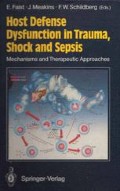Abstract
Bacterial sepsis is one of the major challenges facing clinicians who treat critically ill and injured patients. This is especially true in those cases in which the immune response is impaired, such as following trauma or major surgery [1], and approximately 75% of late deaths following trauma are attributable to systemic sepsis [2]. The progression from sepsis to multiple organ failure and death is complex and depends on a number of factors. Among these factors are a variety of specific and nonspecific host defense mechanisms, including phagocytosis, complement activation, and specific antibody production. In recent years, it has also become clear that specific cell-mediated responses also play important roles in the control of bacterial infection, and it is therefore possible that such responses influence the outcome of sepsis. Pseudomonas aeruginosa is an important cause of morbidity and mortality in severely compromised patients, and it is therefore under intense study. Animal models of infection with this organism have required extensive pretreatment with cyclophosphamide [3], very large numbers of bacteria [4, 5], or full-thickness burn [6, 7] in order to produce susceptibility to sepsis.
Access this chapter
Tax calculation will be finalised at checkout
Purchases are for personal use only
Preview
Unable to display preview. Download preview PDF.
References
Miller SE, Miller CL, Trunkey DD (1982) The immune consequences of trauma. Surg Clin North Am 62:167
Baker CC (1989) Macrophage- T cell interactions in surgical sepsis. In: Faist E, Ninnemann J, Green DR (eds) Immune consequences of trauma shock and sepsis. Springer, Berlin Heidelberg New York, p 63
Cryz SJ, Furer E, Germanier T (1983) Simple model for the study of Pseudomonas aeruginosa infections in leukopenic mice. Infect. Immun. 39:1067.
Grogan JB (1975) Pseudomonas aeruginosa infection in mice after treatment with cyclophosphamide. Arch Surg 110:1473
Ozaki Y, Ohashi T, Minami A, Nakamura S (1987) Enhanced resistance of mice to bacterial infection induced by recombinant human interleukin-1α. Infect Immun 55:1436
McRipley RJ, Garrison DW (1964) Increased susceptibility of burned rats to Pseudomonas aeruginosa. Proc Soc Exp Biol Med 111:336.
Stieritz DD, Holder IA (1975) Experimental studies of the pathogenesis of infections due to Pseudomonas aeruginosa: description of a burned mouse model. J Inf Dis 131:688–691
Grobmeyer AJ, Kerlan RA, Peterson CM, Dragstedt LR (1984) Barium peritonitis Am Surg 50:116.
Bohnen JMA, Christou NV, Meakins JL (1987) Suppression of delayed cutaneous hypersensitivity and inflammatory cell delivery by sterile barium peritonitis. J Surg Res 43:430.
Wichterman KA, Baue AE, Chaudry IH (1980) Sepsis and septic shock—a review of laboratory models and a proposal. J. Surg Res 29:189.
Baker CC, Chaudry IH, Gaines HO, Baue AE (1983) Evaluation of factors affecting mortality following sepsis in a murine cecal ligation and puncture model. Surgery 94:331.
Coligan JE, Kruisbeek AM, Margulies DH, Shevach EM, Strober W (1991) Current protocols in immunology. Wiley, New York
Farrar JJ, Fuller-Bonar J, Simon PL, Hilfiker ML, Stadler BM, Farrar WL (1980) Thymoma production of T cell growth factor (interleukin 2). J Immunol 125:2555.
Mosmann TR, Coffman RL (1989) TH1 and TH2 cells: Different patterns of lymphokine secretion lead to different functional properties. Ann Rev Immunol 7:145.
Chong KT (1987) Prophylactic administration of interleukin-2 protects mice from lethal challenge with gram-negative bacteria. Infect Immun 55:668
Weyand C, Goronzy J, Fathman CG, O’Hanley P (1987) Administration in vivo of recombinant interleukin 2 protects mice against septic death. J Clin Invest 79:1756.
Goronzy J, Weyand C, Quan J, Fathman CG, O’Hanley P (1989) Enhanced cell-mediated protection against fatal Escherichia coli septicemia induced by treatment with recombinant IL-2 J Immunol 142:1134.
Iizawa Y, Nakao M, Kondo M, Yamazaki T (1990) Protective effect of recombinant human interleukin-2 against lethal infection caused by Klebsiella pneumoniae. Microbiol Immunol 34:185.
Author information
Authors and Affiliations
Editor information
Editors and Affiliations
Rights and permissions
Copyright information
© 1993 Springer-Verlag, Berlin Heidelberg
About this chapter
Cite this chapter
Richards, R., Green, D.R. (1993). Local Administration of Interleukin-2 Protects Mice from Lethal Intra-Abdominal Bacterial Sepsis. In: Faist, E., Meakins, J.L., Schildberg, F.W. (eds) Host Defense Dysfunction in Trauma, Shock and Sepsis. Springer, Berlin, Heidelberg. https://doi.org/10.1007/978-3-642-77405-8_162
Download citation
DOI: https://doi.org/10.1007/978-3-642-77405-8_162
Publisher Name: Springer, Berlin, Heidelberg
Print ISBN: 978-3-642-77407-2
Online ISBN: 978-3-642-77405-8
eBook Packages: Springer Book Archive

